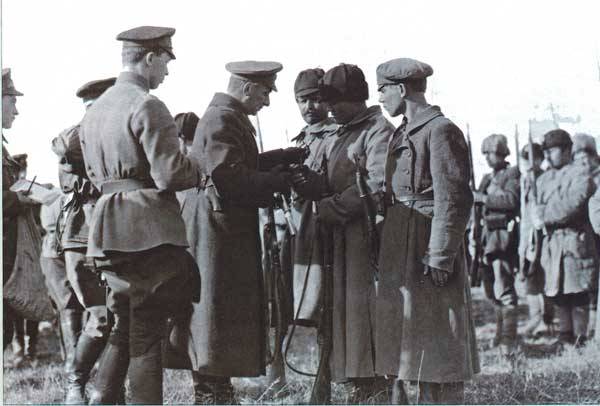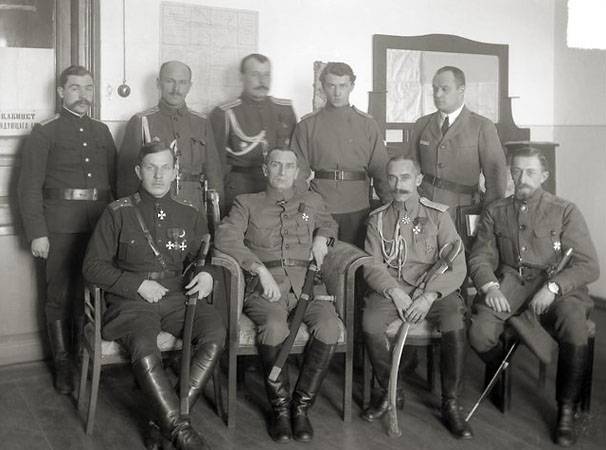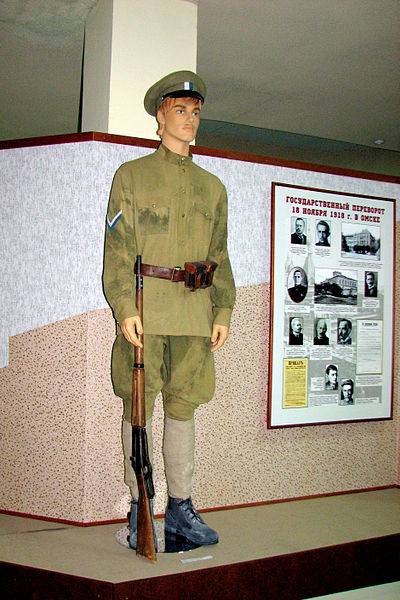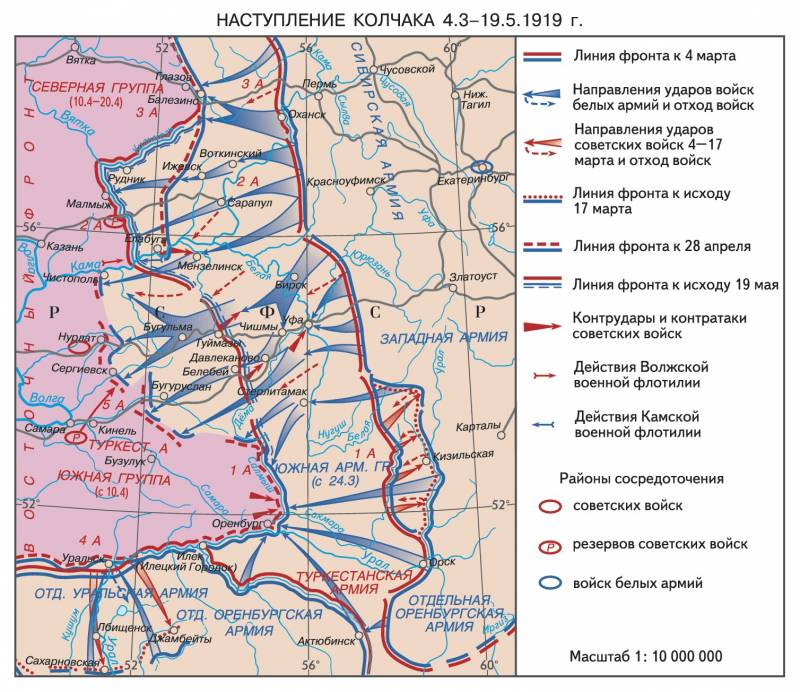How did the "Flight to the Volga"
General situation on the Eastern Front
At the start of the 1919 campaign of the year, a temporary balance of power was established on the Eastern Front. The White Army had a slight superiority in manpower (by the beginning of May 1919, the Red Army gained superiority in the number of troops), and in the Reds in firepower. At the same time, the Reds began to catch up with Whites in organization and combat capability.
At the end of 1918, the beginning of 1919, the parties exchanged blows. At the end of November 1918, the White forces launched the Perm operation and, December 21 took Kungur, December December - Perm (). The 24 Red Army suffered a heavy defeat. There was a threat of losing Vyatka and the collapse of the entire northern flank of the Eastern Front of the Red Army. Only emergency measures allowed to rectify the situation. In January 3, the Red Command organized a counter-offensive in order to repel Kungur and Perm. The offensive was led by the troops of the 1919 and 2 armies, the shock group of the 3 armies (auxiliary attack on Krasnoufimsk). However, mistakes of command, poor preparation, weakness of forces (there was no superiority over the enemy), weak interaction led to the fact that the task was not fulfilled. Reds pressed the enemy, but could not break through the front and went on the defensive.
A partial defeat in the Perm direction was compensated by the victory of the Reds in the main direction - the Ufa direction and in the Orenburg one. 31 December 1918, the Red Army occupied Ufa, and 22 January 1919, the units of the 1 Red Army in Orenburg merged with the Turkestan Army, advancing from Turkestan. 24 January 1919, the 4 Red Army troops took Uralsk. In February, 1919, the 4-I Red Army under the command of Frunze, deeply penetrated between the forces of the Orenburg and Ural Cossacks, advancing to the line Lbishchensk - Iletsk - Orsk.
Thus, during the winter campaign of 1918 - 1919, the Red Army managed to reach the Urals ridge, the last frontier before Siberia, where the main vital centers of the White Army were located. The fights on the Perm and Ufa directions showed a situation of unstable strategic equilibrium on the Eastern Front.

Supreme Commander Kolchak rewards his soldiers
Red Army
On the northern flank of the Eastern Front of the Red Army there were two Soviet armies - 2 and 3, commanders respectively I.I. Shorin and S.A. Mezheninov. They numbered about 50 thousand bayonets and sabers, with 140 guns and about 960 machine guns. The 2-I army was covered by the Srapul army, the Perm-Vyatka army - by the 3-I army. They opposed the Siberian army of whites. In the center of the front was the 5-I army of J. K. Blumberg (soon he was replaced by M. N. Tukhachevsky). It consisted of 10 - 11 thousand fighters with 42 guns and 142 machine guns. She was opposed by the Western army of whites. On the southern flank were the 1-I army — Commander G. D. Guy; the 4 Army — Commander M. V. Frunze; and Turkestan Army — Commander V. G. Zinoviev. They numbered 52 thousand bayonets and checkers with 200 guns and 613 machine guns. They were opposed by the Separate Orenburg Army of Dutov, which suffered a defeat retreated to the steppe, and the Separate Ural Army. In total, the Red Army of the Eastern Front at the start of the battle numbered more than 110 thousand people, about 370 guns, more than 1700 machine guns, 5 armored trains.
As a result, at the time of Kolchak's army, the red Eastern Front had strong flanks and a weak stretched center. On the northern operating lines, the forces of the Reds and the Whites were almost equal. The group of Red armies in the south, although it was heavily scattered over space, had a serious superiority over the enemy (52 thousand people against 19 thousand). And the weak 5 th Red Army with 10 thousand soldiers was against almost 50 thousand enemy groupings.
The Soviet command planned to develop an offensive in the southern direction (by the forces of the 4, Turkestan and 1 armies) and complete the liberation of the Ural and Orenburg regions from the White Cossacks. Then the 1 Army I was supposed to launch an attack on Chelyabinsk in two columns. The right column moved bypassing the Ural range from the south, through Orenburg - Orsk - Troitsk, and the left column from Sterlitamak was aimed at Verkhneuralsk, crossing the Ural mountains, and from there moved to Chelyabinsk. The 5 Army had to overcome the Ural Mountains in its sector, going out to the rear of the Perm enemy group, and assisting the right flank of the 2 Army. The 2 Army was to cover the left flank of the Permian White group. 3-I army received an auxiliary task of tying the whites from the front.
It should be noted that the rear of the Red Eastern Front at that time was fragile. The policy of "war communism", in particular, the food surplus was hard received by the peasantry of the Volga region. In the near rear of the Red Army, a wave of peasant uprisings swept through Simbirsk and Kazan provinces. In addition, part of the forces of the Eastern Front were redeployed to the South, which weakened the position of the Red armies before the offensive of Kolchak's troops.
Reorganization of the Russian army
In December 1918, a radical reorganization of the military command was carried out. Admiral Kolchak completed the work begun by General Boldyrev on reorganizing the management of the white armed forces of Eastern Russia. 18 December 1918, the supreme commander ordered the corps areas of the Siberian army to be abolished and military districts created instead: West Siberian with headquarters in Omsk (Tobolsk, Tomsk and Altai provinces, Akmola and Semipalatinsk regions); Central Siberian District with headquarters in Irkutsk (it included the Yenisei and Irkutsk provinces, the Yakutsk region); The Far Eastern District with its headquarters in Khabarovsk (it included Amur, Primorsk and Zabaikalye regions, the northern part of Sakhalin Island. In January 1919, the names of military districts were replaced by Omsk, Irkutsk and Priamur, respectively. Also, the “supreme ruler” approved the circle of the Orenburg Cossack army of the Orenburg military district with headquarters in Orenburg (this district included the Orenburg province).
Also for operational management, the Supreme Commander Admiral Kolchak was formed. The chief of staff of the headquarters of the Supreme Commander was Major General D. A. Lebedev, and the chief of staff of the Eastern Front — B. Theological. December 24 The Eastern Front troops were divided into Siberian, Western and Orenburg separate armies, the Urals separate army was also subordinate to the Stavka. The Siberian and People's armies were abolished. The new Siberian army under the command of General R. Gaida was formed on the basis of the Yekaterinburg group of troops (it consisted of the 1918th Central Siberian Corps, the 1th Steppe Siberian Corps, the Votkinsk Division and the Krasnoufimsky Brigade). By the beginning of the spring offensive of 3, the Siberian army numbered about 1919 thousand bayonets and sabers, 50 - 75 guns and 80 machine guns.

At the headquarters of the Siberian Army on the eve of the general offensive. In the first row, from left to right: Commander R. Gaida, A. V. Kolchak, Chief of Staff B.P. Theological. February 1919 of the year
The Western Army under the command of General M. Khanzhin, commander of the 3 Urals Corps, was established on the basis of the 3 Urals Corps of the Samara and Kama Group of Forces (hereinafter the 8 Ufa and 9 Volga Corps). Then the composition of the Western Army was replenished at the expense of the 2 of the Ufa and 6 of the Ural corps. By the beginning of spring 1919, the Western army had more than 38,5 thousand bayonets and sabers, about 100 guns, 570 machine guns. Also, the Western Army was subordinated to the Southern Army Group under the command of General P. Belov (finally formed by 24 in March 1919 of the year), as part of the 4-th Army Corps and the Consolidated Sterlitamak Corps. The southern army group numbered about 13 thousand bayonets and sabers with 15 guns and 143 machine guns.
On the basis of the troops of the South-Western Front, the Orenburg Separate Army was formed under the command of General A.I. Dutov. The Orenburg Army included: 1 and 2 of the Orenburg Cossack Corps, 4 of the Orenburg Army, Combined Sterlitamak and Bashkir (4 Infantry Regiment) Corps and 1 of the Orenburg Cossack Plastun Division. The number of the Orenburg army reached 14 thousand people. A separate Ural army under the command of General N. A. Savelyev (from April V.S. Tolstov) was formed from the Ural Cossack army and other military units established within the Ural region. It consisted of: 1 Ural Cossack Corps, 2 Iletsk Cossack Corps, 3 I Ural-Astrakhan Cossack Corps. The number of armies at different times ranged from 15 to 25 thousand people. In addition, the 2 Steppe Siberian Separate Corps under the command of General V.V. Brzezovsky acted on the Semirechensk direction.
Total white armed forces of the East of Russia in the spring 1919, there were about 400 thousand people. At the very front, there were about 130 -140 thousand bayonets and sabers.

Private of the Siberian army. Exhibit of the Omsk State Museum of History and Local Lore. Source: https://ru.wikipedia.org
White Command Strategy
The fall of Kazan, the collapse of the People’s Army, the defeat in the Samara-Ufa direction, and the withdrawal from the front of the Czechoslovak troops did not lead to the refusal of the Siberian government of Kolchak from an offensive strategy. At the same time, the Kolchak government inherited the strategy of the Directory, the main attack on the Perm-Vyatka direction, with the aim of connecting with the Northern Front the Whites and the Entente troops. Then it was possible from Vologda to develop the movement to Petrograd. The offensive was also planned to be developed along the lines of Sarapul - Kazan, Ufa - Samara, then the Moscow direction emerged. With the success of the operation and the output of the whites to the Volga, the offensive was to continue and develop into a march on Moscow from the north, east and south. This made it possible to occupy more industrialized and industrially developed provinces, to join forces with the army of Denikin. As a result, Moscow, after the defeat of the Eastern Front of the Reds and access to the Volga, was planned to take in July 1919 of the year.
Ataman Dutov, the commander of the Orenburg army, offered to deliver the main blow on the southern flank in order to unite and create a common front with Denikin’s army in southern Russia. However, the concentration in the Orenburg region of the main strike grouping of the Kolchak army was difficult due to the lack of direct communication - by rail to Orenburg from Omsk could only be reached via Samara. In addition, there was a political factor - Denikin has not yet recognized the all-Russian power of Kolchak. Therefore, it was decided that the armies of Denikin and Kolchak would fight separately. Kolchak declared: “Whoever gets to Moscow first will be the lord of the situation.”
In turn, the Commander-in-Chief of the Armed Forces of Southern Russia (VSYUR) Denikin made plans for the campaign for 1919 a year exaggerating the importance of helping allies in the South of Russia. It was planned that the divisions of the Entente would help the whites to clear Russia of the Bolsheviks. In reality, the masters of the West were not going to get involved in a slaughter in Russia, preferring to act with the hands of whites and nationalists. Denikin, hoping for the help of the Entente, planned to end the fighting in the North Caucasus, not to allow Red to occupy Ukraine, and then also to go to Moscow, with a simultaneous attack on Petrograd and an advance along the right bank of the Volga. That is, the former, instead of concentrating the main forces in one direction, scattered them in a huge space.
Thus, the strategy of the Siberian government had a shaky foundation. First, the white command could not organize the interaction of the main forces of the White Army - the troops of Kolchak and Denikin to strike at the enemy. Kolchak's army repeated the strategic mistake of the People’s Army and the Czechoslovaks — considerable forces were again focused on the Permian-Vyatka direction, although it was already clear that the Northern Front was weak and passive, of secondary importance. At the same time, the Czechoslovakians, the most powerful part of the anti-Bolshevik front in the east of Russia, left the front.
Secondly, Kolchak's army had a rather weak material base, human reserves. The bulk of the population, social groups did not support the Kolchak government and its goals. What ultimately led to mass resistance in the rear, powerful uprisings that became one of the main prerequisites for the future defeat of Kolchak’s Russian army. True, at the very beginning, by suppressing the democratic counter-revolution of the “founding members” (left wing of the feminist revolutionaries), the military could temporarily bring order to the rear and mobilize, which, based on strong officer personnel, created a strong foundation for the Russian army of Kolchak.
In such a situation, the Siberian white command could only count on temporary success in one of the operational areas. But this success was bought at the cost of complete strategic exhaustion of forces — troops, material and human resources, and reserves. For the further development of offensive operations in such a huge area, it was necessary to successfully conduct a series of mobilizations (mainly peasants) both in the rear and in occupied territories. However, the policy of the Siberian government ruled out the possibility that the peasantry would support the whites. Moreover, each new mobilization of the peasantry further set up the peasantry against the Kolchak government, and worsened the combat capability of the Russian army itself (sabotage, mass desertion, switching to the Reds, etc.).
That is, the Russian army of Kolchak could inflict one powerful, but limited in time and space strike. It was logical to strike the main blow south of Ufa in order to connect with Denikinians. However, here, apparently, the interests of the white command were ignored by the British. The formation of a single strong white army and the possible merger of the white governments of southern Russia and Siberia contradicted the interests of the masters of the West and London. The British shackled political will and operational thinking of Kolchak, pushed the whites towards Vyatka and Vologda. As a result, White decided to inflict two strong blows on both Vyatka and the Middle Volga, although they lacked the strength and resources to do so. Subsequent events fully revealed the shortcomings of the White Command’s strategic plan.
Three white armies participated in the strategic offensive: 1) The Siberian army of Gaida was already focused on the Vyatsk-Vologda direction, between Glazov and Perm; 2) Western army gene. Khanzhina deployed on the front Birsk - Ufa; 3) The Orenburg army was supposed to strike at the Orsk-Orenburg line. The white army at the front numbered about 113 thousand people with 200 guns. In the three shock groups on the Vyatka, Sapulu and Ufa directions there were more than 90 thousand bayonets and sabers. The strategic reserve of Kolchak Headquarters was the 1 th Volga Kappel Army Corps (3 rifle divisions and cavalry brigade) in the Chelyabinsk-Kurgan-Kustanai area and three infantry divisions that formed in the Omsk region.
Thus, the army of Kolchak struck two strong blows in the northern and central directions. A successful offensive in the center made it possible to cut the lines of communications of the strong southern army group of the red Eastern Front and push the three red armies south. Thus, the white command could liberate and receive help from the Orenburg and Ural Cossacks, to provide the Turkestan direction.
To be continued ...

Information